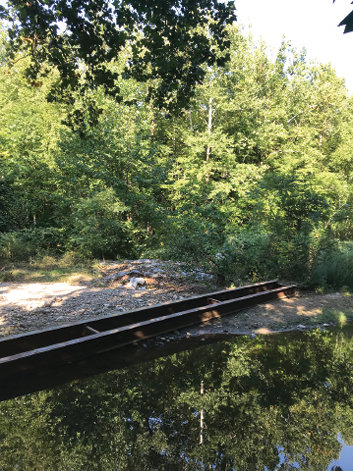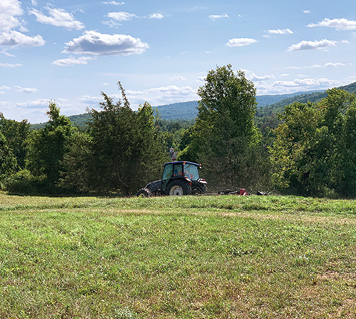Developing and maintaining the views at Holcomb Farm—especially the views from the land east of Simsbury Road, looking back over the Farm toward Broad Hill—is a never-ending task for the Friends, led by our Stewardship committee and many volunteers. Our annual field mowing of the east side fields—following on the heels of the removal of the hazardous ash trees profiled in last month’s Drummer—requires an investment and is just one example of how we put our members’ and donors’ contributions to work for Granby. As in past years, Ted D’Onofrio, owner of TR Landworks in East Hartland, trucked in his large tractor and triple-wide brush hog. He mowed and mowed. This delighted crows and hawks, as well as a resident coyote, that Ted named Benny, who followed Ted as he mowed to snatch up the field rodents, just as wildlife have done for years after farmers cut hay.
With the dry summer and his usual care, Ted did not risk bogging down anywhere. He was able to cut close to the hedgerows and slalom around the planted trees of the Holcomb Tree Trail. The invasive multi-flora rose, autumn olive, bittersweet and their comrades fell before the blade, along with a dense population of canary grass, which dominates many open areas. Ted understands our needs, as he does considerable habitat restoration and field maintenance work for state environmental agencies, refuges, including McLean Game Refuge, and land trusts throughout the northeast. We are lucky to have him mow every year.
Another Stewardship activity is the maintenance of our 10+ miles of trails. It has been a year since the 100-year flood from Hurricane Irene took out the pedestrian bridge connecting the farm fields to the western woodlands. The Friends, along with the Town, are still working to determine how best to respond. The problem is that the Salmon Brook is alive and well, which means it rises and falls regularly, and moves; in this case, generally west from the higher ground, toward the east and the floodplains that we farm.
An intrepid group of volunteers, including people who engineered and built bridges for a living—gratefully referred to as our “Bridge Club”—are still exploring options. In the meantime, the old bridge needs to get removed from the stream, and this requires hours of labor to extract the wooden planking from the I-beams. The next step will involve large machinery to extract the steel. As the plans for a new bridge come together, we will share more on this challenging and exciting project.

